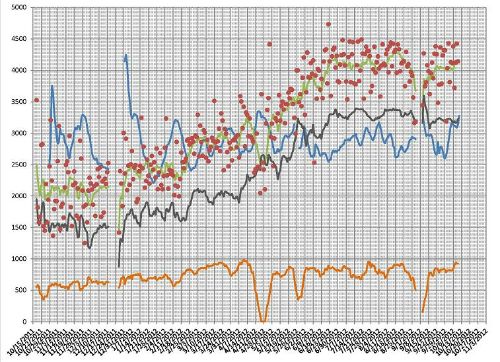Figure your ACTUAL TDEE without a calculator
Replies
-
Really? Because I can't find High Intensity Interval Training or High Intensity Strength Training in MFP. Come to think of it, I couldn't find CrossFit in there either. Which is why I prefer the TDEE method.MFP makes this about as simple as it could possibly be. Why oh why does everyone make this sooooo freakin complicated?
It's really not rocket science.
Collect data over a number of days, divide the data by the number of days and you have an average number that shows you EXACTLY what the effect of calories and your exercise has on YOUR body. Knowing 3500 calories is a pound, adjust accordingly.
Pretty basic.0 -
Bump
 0
0 -
lmao......it said my TDEE is five
I'm going to eat at TDEE for maintenance and I'm going to blame you if this goes wrong 0
0 -
Thanks for the idea/post. Makes sense.0
-
bump0
-
Does anybody really take the time out of their day to read long messages?
:laugh:
I do when I'm at work with no "work" to do!0 -
SIMPLE VERSION:
I did something similar because I love playing with Excel just too much. And I had time...lol
Tracked daily for 6 months...calories in and weight.
Used food scales and everything to be super accurate.
I multiplied pounds lost by 3500 and added that to total calories in. Divided that number by how many days I tracked. And voila...TDEE for me.
Which by the way is about 300 less than every calculator out there.0 -
Mine were off a little over 300 as well. Good point about the food scales too. Estimating too often would definitely be a bad thing.SIMPLE VERSION:
I did something similar because I love playing with Excel just too much. And I had time...lol
Tracked daily for 6 months...calories in and weight.
Used food scales and everything to be super accurate.
I multiplied pounds lost by 3500 and added that to total calories in. Divided that number by how many days I tracked. And voila...TDEE for me.
Which by the way is about 300 less than every calculator out there.0 -
BUMP0
-
Mine were off a little over 300 as well. Good point about the food scales too. Estimating too often would definitely be a bad thing.SIMPLE VERSION:
I did something similar because I love playing with Excel just too much. And I had time...lol
Tracked daily for 6 months...calories in and weight.
Used food scales and everything to be super accurate.
I multiplied pounds lost by 3500 and added that to total calories in. Divided that number by how many days I tracked. And voila...TDEE for me.
Which by the way is about 300 less than every calculator out there.
Which works out to over half a pound a week...ugh. So not fun.0 -
I'm a numbers person too. I read the whole thing and I am excited to see how it works. I've been wanting an equation or something because I have heard that the TDEE you get is not accurate for individuals. Thank you so much for sharing.0
-
YW. I tried not to overcomplicate it. I have a habit of doing that sometimes. Haha.....I'm a numbers person too. I read the whole thing and I am excited to see how it works. I've been wanting an equation or something because I have heard that the TDEE you get is not accurate for individuals. Thank you so much for sharing.0 -
Hamunahamunahamuna..... can't I just have a taco?0
-
Bump - bc I'm a numbers person and number crunching is fun! :bigsmile:0
-
Like it. But then I already do this with an excel spreadsheet because I am a supergeek (and an engineer, so naturally I like data).
Despite running 3x a week and lifting 2-3x, my spreadsheet would seem to indicate my TDEE is around 1700 +/- 50. 1700 is what scooby and other online calculators says is my "sedentary" TDEE. So yes I am betting there are a lot of people out there over eating. Though, I also worry about the long term effects of dieting on one's metabolism. So perhaps this 1700 TDEE is a depressed number that I could somehow raise up with some time spent eating at maintenace? I don't know. But when one is losing 1/2 lb or less every week, and non linearly, it is nice to have something to track to see overal progress towards the goal. Enjoyed the post.0 -
At first I thought, "yep, maybe overthinking things just a bit". But this is actually a great idea, and probably a good idea to do it every 6 weeks, because as you lose weight and/or improve fitness your TDEE will likely change.
I, for one, know that the online TDEE calculators are not correct for me.0 -
Knowing 3500 calories is a pound, adjust accordingly.
That's the point I was trying to make earlier. Roughly 3,500 is a pound of fat, but it's not a pound on the scale. Or, put differently, if I lose 3 pounds, not all of it was fat. This is going to throw your calculations off.0 -
Bump0
-
I haven't read all the responses, so I don't know if someone has pointed this out.
Your calculations are merely a reflection of the past - that is, an average of the past several weeks.
Your formula doesn't take into account that your BMR (and therefore your TDEE) drops as you lose weight. The BMR/TDEE of a 150 pound person is lower than that of a 155 pound person, for example.
Your suggestion of how to calculate your TDEE is a regression to the mean. If at 150 lbs you start eating at a deficit of that mean TDEE (for the last six weeks) then you will be eating at less of a deficit than the deficit that resulted in the original 6 week loss.
This is a recipe for a plateau. You will think that your deficit is x (or whatever variable you used) when it is really y.0 -
Obvoulsy your TDEE is going to drop as you lose weight. You have to recalculate obviously when weight loss slows down. That is a given. There are plenty of posts on here about that. But it's good that you point this out as I took it for obvious and failed to mention it, but it may not be so obvious to some people.I haven't read all the responses, so I don't know if someone has pointed this out.
Your calculations are merely a reflection of the past - that is, an average of the past several weeks.
Your formula doesn't take into account that your BMR (and therefore your TDEE) drops as you lose weight. The BMR/TDEE of a 150 pound person is lower than that of a 155 pound person, for example.
Your suggestion of how to calculate your TDEE is a regression to the mean. If at 150 lbs you start eating at a deficit of that mean TDEE (for the last six weeks) then you will be eating at less of a deficit than the deficit that resulted in the original 6 week loss.
This is a recipe for a plateau. You will think that your deficit is x (or whatever variable you used) when it is really y.
What people have to realize is that weight loss is not linear and it is a long process and not screw with things or over-react to quickly. Personally if I didn't see a change in a month, I would start recalculating and adjusting.0 -
I do the similar, however:
- I don't use TDEE, instead non-exercise calorie burn, I estimate exercise calories as I'd like to be accomodating to any exercise shifts.
- Instead of using weigh in values, I use a weighted moving average of weight in values for how much I weigh on any given day, it helps to tame the noise.
- I track it over a shorter time scale, 2 weeks. It varies over time, keeping tabs on this variance is important to me.
- This really is just a spreadsheet thing. Input a couple values a day (weight, calories in/out, protein) and let it do its thing. This isn't some head exploding analysis, 30 seconds of work a day, tops.
- I prefer to graph things to visually analyze numbers. It is a more intuitive way to analyze data.
Here's a little printout of my full diet graph:
Scale is days (x) and calories (y)
Red dots are daily food intake
Green line is the smoothed 7 day average of food intake
Orange line is the smoothed 7 day average of exercise burn
Black line is the smoothed 7 day average of net intake
Blue line is a smoothed 14 day non-exercise TDEE
Black under blue = losing, black over blue = gaining
I lost 75 lbs, gained 15 lbs, and am just entering another cut. Never had a plateau, always gain or lose at pretty much exactly the rate I want to gain/lose. Weigh ins are merely confirmations.0 -
Awesome!I do the similar, however:
- I don't use TDEE, instead non-exercise calorie burn, I estimate exercise calories as I'd like to be accomodating to any exercise shifts.
- Instead of using weigh in values, I use a weighted moving average of weight in values for how much I weigh on any given day, it helps to tame the noise.
- I track it over a shorter time scale, 2 weeks. It varies over time, keeping tabs on this variance is important to me.
- This really is just a spreadsheet thing. Input a couple values a day (weight, calories in/out, protein) and let it do its thing. This isn't some head exploding analysis, 30 seconds of work a day, tops.
- I prefer to graph things to visually analyze numbers. It is a more intuitive way to analyze data.
Here's a little printout of my full diet graph:
Scale is days (x) and calories (y)
Red dots are daily food intake
Green line is the smoothed 7 day average of food intake
Orange line is the smoothed 7 day average of exercise burn
Black line is the smoothed 7 day average of net intake
Blue line is a smoothed 14 day non-exercise TDEE
Black under blue = losing, black over blue = gaining
I lost 75 lbs, gained 15 lbs, and am just entering another cut. Never had a plateau, always gain or lose at pretty much exactly the rate I want to gain/lose. Weigh ins are merely confirmations.0 -
I'm a numbers person too so I get it. The calculators are all estimates. Our diaries are all estimates. The NI on packages are all estimates. The calories burned reading on a HRM is an estimate. Even the scale can be deceiving... for instance: For the last 3 weeks I've eaten 2000 calories/day for 1 week, 2100 calories/day for 1 week and now 2200 calories/day for the last week and a half. My scale weight first thing in the morning has remained EXACTLY the same. But in that time, my thighs have shrunk 1/4" and my waist has shrunk 1". So obviously 2200 is still under maintenance even though I'd have no scale movement data to plug into the formula. I just know I'm still burning fat because my pants are looser.
Everything is an estimate. Find what works and keep doing it until it doesn't work anymore. Then change it up and find the next thing that works.0 -
great idea! bump....0
-
Bump - bc I'm a numbers person and number crunching is fun! :bigsmile:
I love crunching numbers too, but I am not pausing my weight loss goals to eat at TDEE for 8 weeks.
:laugh:0 -
Everything is an estimate. Find what works and keep doing it until it doesn't work anymore. Then change it up and find the next thing that works.
This is *exactly* what I have learned. so long as my current calories/macros are working for me, I'm happy and will continue to keep with what is working.0 -
I'm a numbers person too so I get it. The calculators are all estimates. Our diaries are all estimates. The NI on packages are all estimates. The calories burned reading on a HRM is an estimate. Even the scale can be deceiving... for instance: For the last 3 weeks I've eaten 2000 calories/day for 1 week, 2100 calories/day for 1 week and now 2200 calories/day for the last week and a half. My scale weight first thing in the morning has remained EXACTLY the same. But in that time, my thighs have shrunk 1/4" and my waist has shrunk 1". So obviously 2200 is still under maintenance even though I'd have no scale movement data to plug into the formula. I just know I'm still burning fat because my pants are looser.
Everything is an estimate. Find what works and keep doing it until it doesn't work anymore. Then change it up and find the next thing that works.
Now THAT is awesome.
Well, ok, it was a tie with the graph barely. Yours is more inspiring though for sure.0 -
WOW....let them eat cake I say!0
-
I did this with my real numbers for the year and discovered that all the online calculators had my TDEE at 200 calories higher than reality.
Here's how I explain your method:
1. Add up all the NET calories for the month.
2. Add up all the pounds lost for the month, and multiply that number by 3500 (# of calories in a pound).
3. Add the Totals together (NET calories + (pounds lost X 3500)).
4. Divide that number by 30 (days in the month).
That give you your personal TDEE. Rinse, repeat monthly. Knowledge is power! (And hoarded knowledge is cheap power, fyi.)0 -
I'm a numbers person too so I get it. The calculators are all estimates. Our diaries are all estimates. The NI on packages are all estimates. The calories burned reading on a HRM is an estimate. Even the scale can be deceiving... for instance: For the last 3 weeks I've eaten 2000 calories/day for 1 week, 2100 calories/day for 1 week and now 2200 calories/day for the last week and a half. My scale weight first thing in the morning has remained EXACTLY the same. But in that time, my thighs have shrunk 1/4" and my waist has shrunk 1". So obviously 2200 is still under maintenance even though I'd have no scale movement data to plug into the formula. I just know I'm still burning fat because my pants are looser.
Everything is an estimate. Find what works and keep doing it until it doesn't work anymore. Then change it up and find the next thing that works.
Now THAT is awesome.
Well, ok, it was a tie with the graph barely. Yours is more inspiring though for sure.
:laugh: That's why we're friends!
But in all honesty, that graph is true greatness :bigsmile:0
This discussion has been closed.
Categories
- All Categories
- 1.4M Health, Wellness and Goals
- 398.1K Introduce Yourself
- 44.7K Getting Started
- 261K Health and Weight Loss
- 176.4K Food and Nutrition
- 47.7K Recipes
- 233K Fitness and Exercise
- 462 Sleep, Mindfulness and Overall Wellness
- 6.5K Goal: Maintaining Weight
- 8.7K Goal: Gaining Weight and Body Building
- 153.5K Motivation and Support
- 8.4K Challenges
- 1.4K Debate Club
- 96.5K Chit-Chat
- 2.6K Fun and Games
- 4.8K MyFitnessPal Information
- 12 News and Announcements
- 21 MyFitnessPal Academy
- 1.5K Feature Suggestions and Ideas
- 3.2K MyFitnessPal Tech Support Questions




















